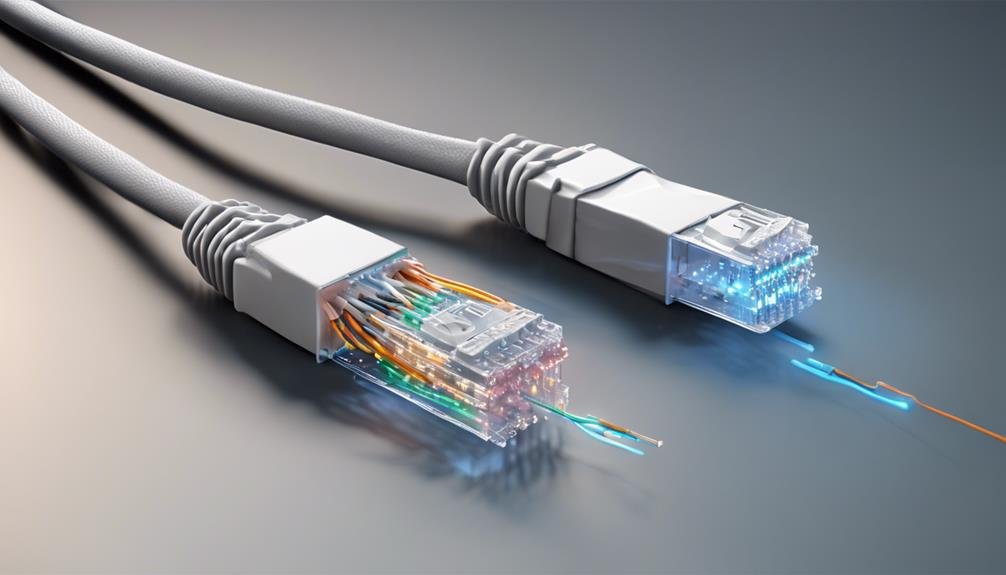What Is Broadband High-Speed Internet, and How Does It Work?
Broadband high-speed internet is a rapid and efficient data transmission method employing technologies such as fiber optics and radio waves. By utilizing these advanced mediums, broadband facilitates the swift and reliable delivery of large data streams to users. Through the intricate workings of fiber optics and radio waves, high-capacity data is transmitted at lightning speeds, ensuring seamless connectivity and enhanced user experiences. Understanding the technical intricacies behind broadband technology reveals the extensive impact it has on modern communication infrastructures and its pivotal role in global connectivity advancements. Invest in broadening your knowledge to discover further details on broadband functionalities and benefits.
Key Takeaways
- Broadband is a high-speed transmission medium using cables or radio waves.
- It ensures fast data transfer, supporting multiple devices and sectors.
- Technologies like fiber optics and radio waves optimize broadband connectivity.
- Broadband modems facilitate high-speed Internet access without manual connections.
- Upgrading to fiber optics and optimizing configurations enhance broadband speed and performance.
Broadband Internet: Definition and Overview
Broadband Internet, a pivotal component of modern connectivity infrastructure, serves as a high-speed and high-capacity transmission medium for data, voice, and video communication across various technologies and transmission mediums such as coaxial cables, fiber optic cables, and radio waves.
Broadband infrastructure plays a critical role in facilitating global connectivity trends. The adoption of broadband is steadily increasing worldwide, with over 4.9 billion internet users in 2021. Global broadband speeds are expected to reach an average of 110.4 Mbps by 2023, greatly enhancing data transmission capabilities.
This growth in broadband usage is essential for supporting various sectors like education, healthcare, and technological advancements, underlining its significance in the digital age.
Broadband Transmission Technologies
The advancement of broadband infrastructure has necessitated a detailed examination of the various transmission technologies that underpin high-speed Internet connectivity. Broadband transmission technologies encompass a range of methods to efficiently transmit data, with two prominent examples being fiber optics and radio waves.
Fiber optics utilize light signals sent through glass fibers to transmit data at incredibly high speeds, making them well-suited for long-distance and high-bandwidth applications. On the other hand, radio waves facilitate wireless communication, enabling connectivity without the need for physical cables.
Understanding the intricacies of these technologies is crucial for optimizing broadband connectivity and ensuring seamless high-speed Internet access for users across different environments and applications.
Broadband Vs. Dial-Up Connections
Comparing the efficiency and speed of broadband and dial-up connections reveals significant differences in their data transmission capabilities and connectivity reliability.
- Broadband Infrastructure
- Internet Connectivity
- Speed and Efficiency
Broadband infrastructure, with its advanced technology and high-speed capabilities, offers a more reliable and faster internet connection compared to dial-up. Broadband guarantees constant internet connectivity, eliminating the need to dial in each time to establish a connection. The speed and efficiency of broadband make it ideal for modern communication needs, allowing for quicker access to information and seamless data transmission. In contrast, dial-up connections are slower, less reliable, and require users to connect and disconnect for each session, making broadband a preferred choice for today's internet users.
Key Broadband Technologies Explained
Among the key technologies that underpin high-speed internet connectivity, diverse transmission mediums play a critical role in enabling efficient data, voice, and video communication. Broadband infrastructure encompasses a variety of technologies such as DSL, cable modem, fiber optics, wireless, satellite, and BPL.
These technologies facilitate broadband expansion by providing high-speed and high-bandwidth communication infrastructure. Broadband infrastructure is crucial for ensuring quick access to information, teleconferencing, and data transmission. As broadband adoption and speeds continue to increase globally, the constant evolution of broadband technologies remains essential for meeting the growing demands of modern communication and connectivity.
Advanced satellite networks, like the Starlink Project by SpaceX, are an emerging frontier in expanding global high-speed Internet access.
Importance of Broadband Speeds
Why is the speed of broadband connectivity essential for modern communication and connectivity infrastructure?
Broadband infrastructure and Internet connectivity rely heavily on high-speed connections to function at their best.
The importance of broadband speeds can be understood through:
- Efficient Data Transmission: Faster speeds enable quicker data transfers, enhancing real-time communication and seamless connectivity.
- Enhanced User Experience: High-speed connections improve the overall user experience by reducing buffering times and ensuring smooth browsing and streaming.
- Support for Multiple Devices: Faster broadband speeds can support multiple devices simultaneously, catering to the demands of modern households and workplaces.
In essence, high broadband speeds play a critical role in supporting the demands of today's digital age, ensuring efficient communication and connectivity across various sectors.
Broadband Modems and Connectivity
Broadband modems serve as essential components in establishing high-speed Internet connectivity, facilitating data transmission through various technologies such as Wi-Fi, DSL, fiber, and satellites.
Broadband modem setup involves connecting the modem to a high-speed Internet connection, whether through DSL or cable networks, to enable an 'always-on' connection. This setup eliminates the need to manually connect before each use, providing seamless access to broadband services.
Broadband connectivity solutions vary based on the technology used, with each offering distinct advantages regarding speed, reliability, and coverage. Whether at home or in the office, a broadband modem is vital for establishing Internet connectivity and ensuring a smooth online experience for various activities requiring high bandwidth.
Enhancing Broadband Speed and Performance
To improve broadband speed and performance, a thorough analysis of existing infrastructure and technological advancements is crucial.
- Implementing Fiber Optic Technology: Upgrading to fiber optic cables can greatly enhance connectivity and provide faster data transmission speeds.
- Optimizing Network Configurations: Fine-tuning network settings and configurations can improve overall user experience by reducing latency and increasing reliability.
- Utilizing Advanced Signal Processing Techniques: Employing cutting-edge signal processing methods can help in maximizing bandwidth utilization and enhancing the efficiency of data transfer.
Conclusion
In the intricate web of digital connectivity, broadband high-speed Internet stands as the crucial beacon of swift and efficient data transmission. Like a well-oiled machine with diverse gears and mechanisms, broadband technology seamlessly facilitates the flow of information across vast networks.
Its importance cannot be underestimated, serving as an essential conduit for economic growth, education, and societal interconnectedness. As the digital landscape continues to evolve, the role of broadband Internet remains paramount in shaping our interconnected world.







